Abstract
We have used one and two dimensional 1H NMR spectroscopy to characterize the binding of a homodimeric thiazole orange dye, 1,1'-(4,4,8,8-tetramethyl-4,8-diaza-undecamethylene)-bis-4- (3-methyl-2,3-dihydro-(benzo-1,3-thiazole)-2-methylidene)-quinolin ium tetraiodide (TOTO), to various double stranded DNA oligonucleotides. TOTO binds strongly to all the oligonucleotides used, but usually more than one complex is observed and exchange between different binding sites broadens the lines in the NMR spectra. Complete precipitation occurs when TOTO is bound to small oligonucleotides. Binding to larger oligonucleotides occurs by bis-intercalation. The 1:1 complex of TOTO with the oligonucleotide d(CCGACTGATGC):d (GCATCAGTCGG) gave only one complex that was shown to be a bis-intercalation in the CTGA:TCAG binding site. The binding to this site was also characterized by studying the TOTO complex with the d(CCGCTGAGC):d(GCTCAGCGG) oligonucleotide. NOE connectivities and molecular modelling were used to characterize the complex. The 1:1 complex of TOTO with the oligonucleotide d(CCGCTAGCG):d(CGCTAGCGG) containing a CTAG:CTAG binding site was similarly characterized by NMR. It was concluded that the binding of TOTO to larger oligonucleotides is site selective with CTAG:CTAG as the preferred binding site.
Full text
PDF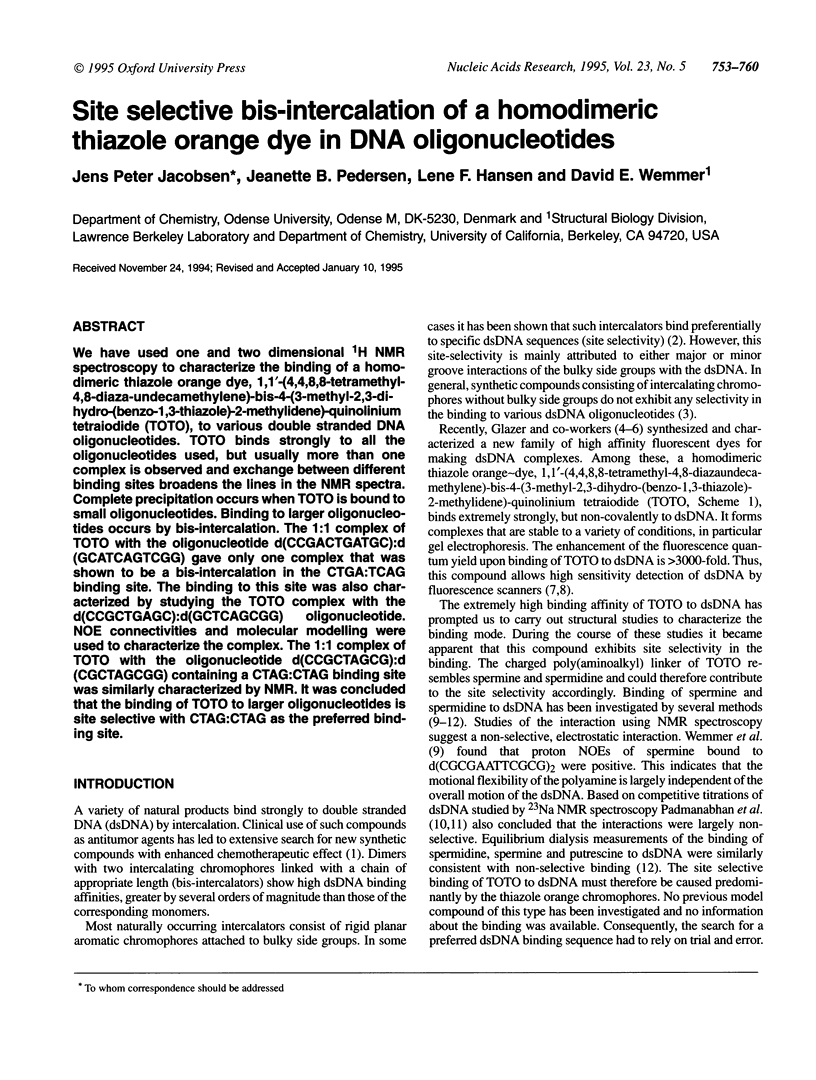
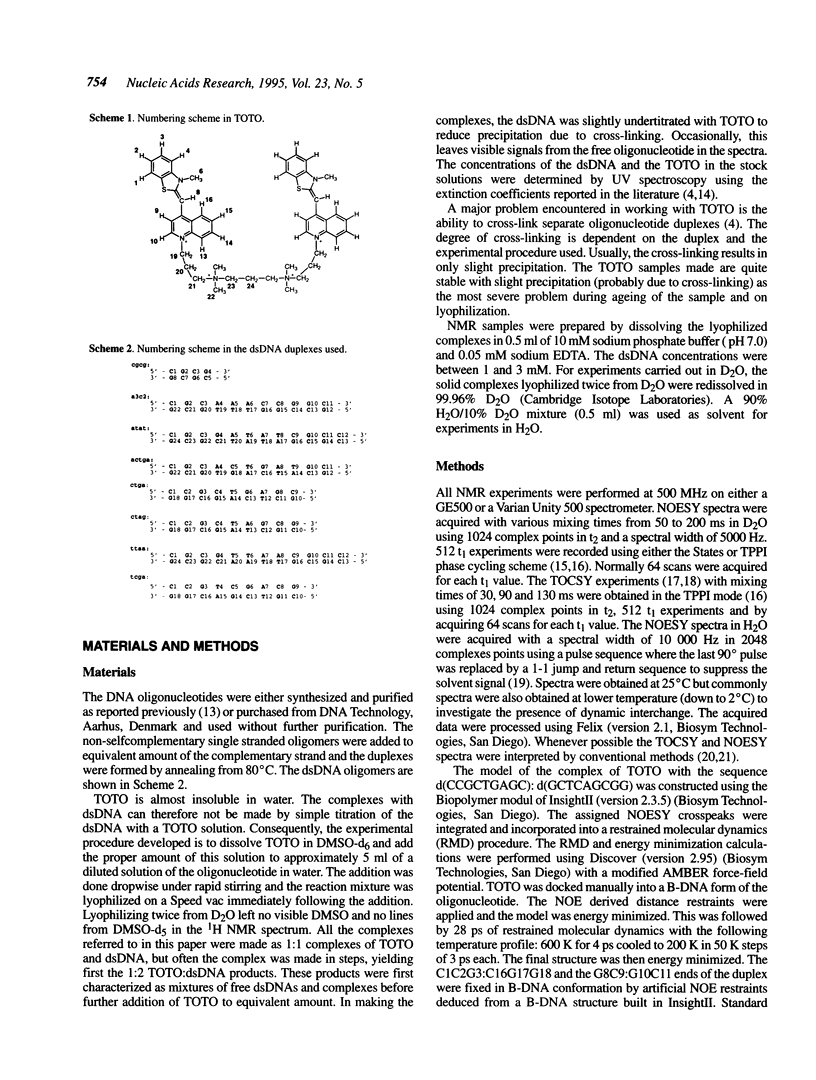
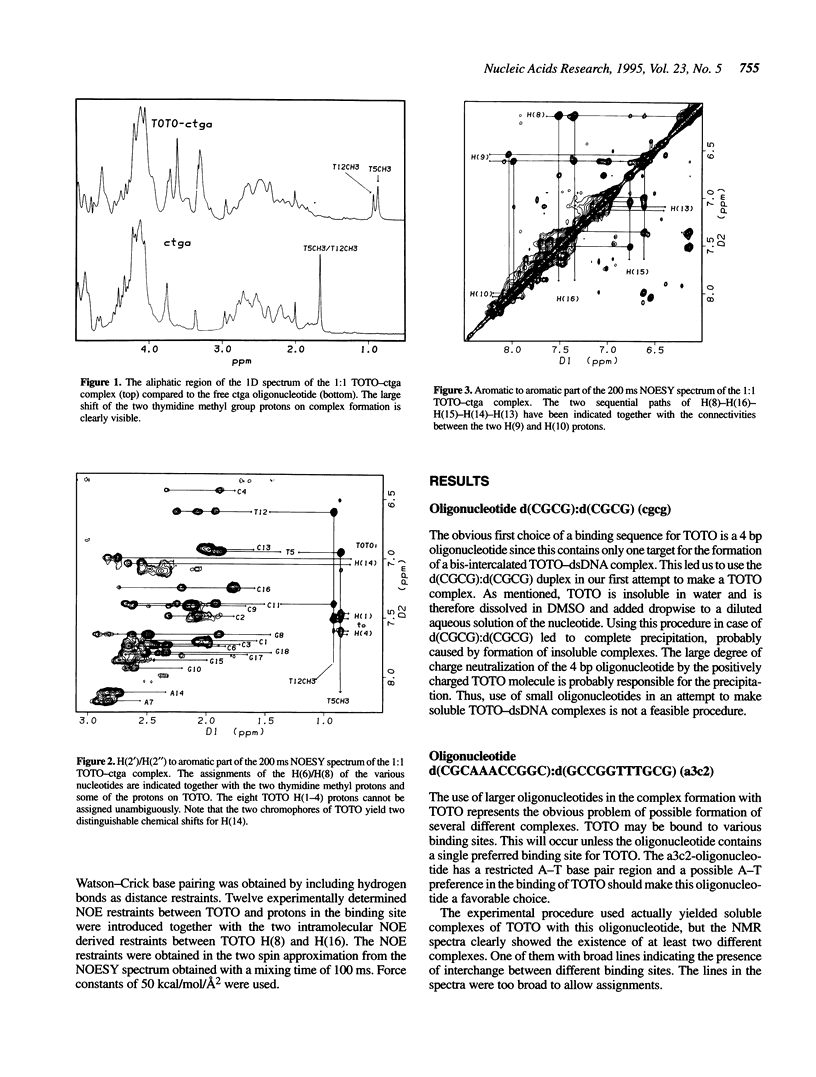
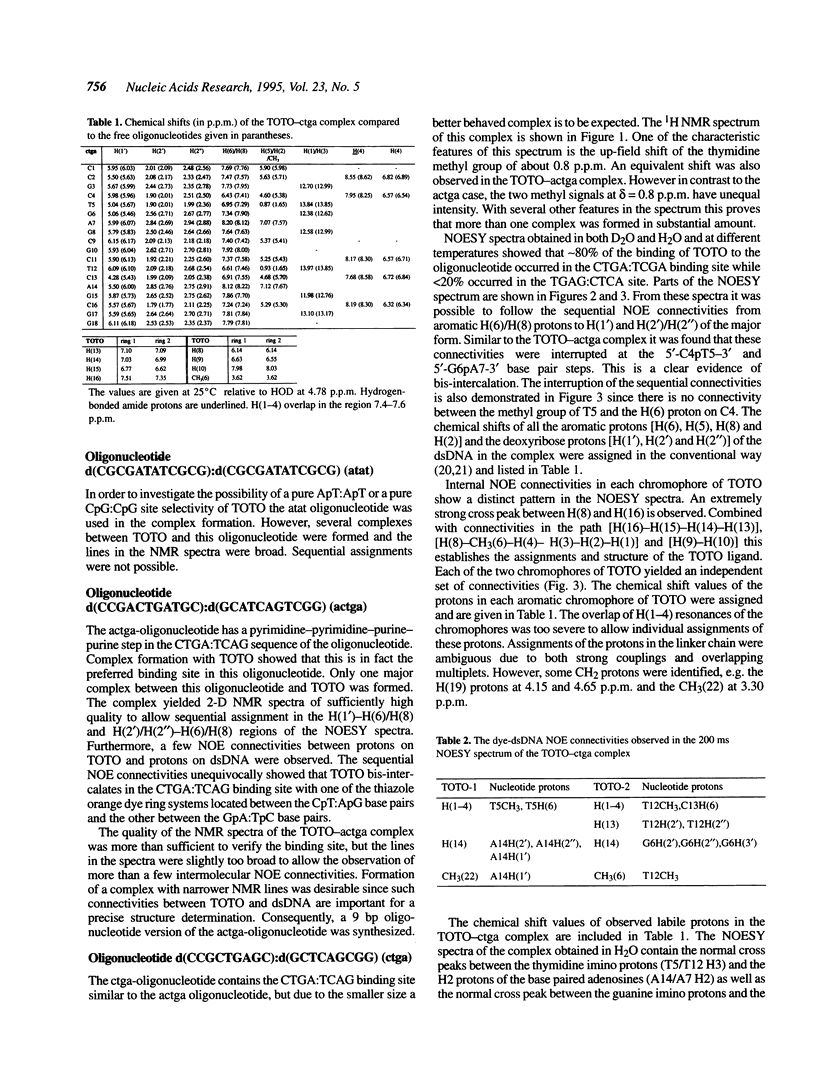
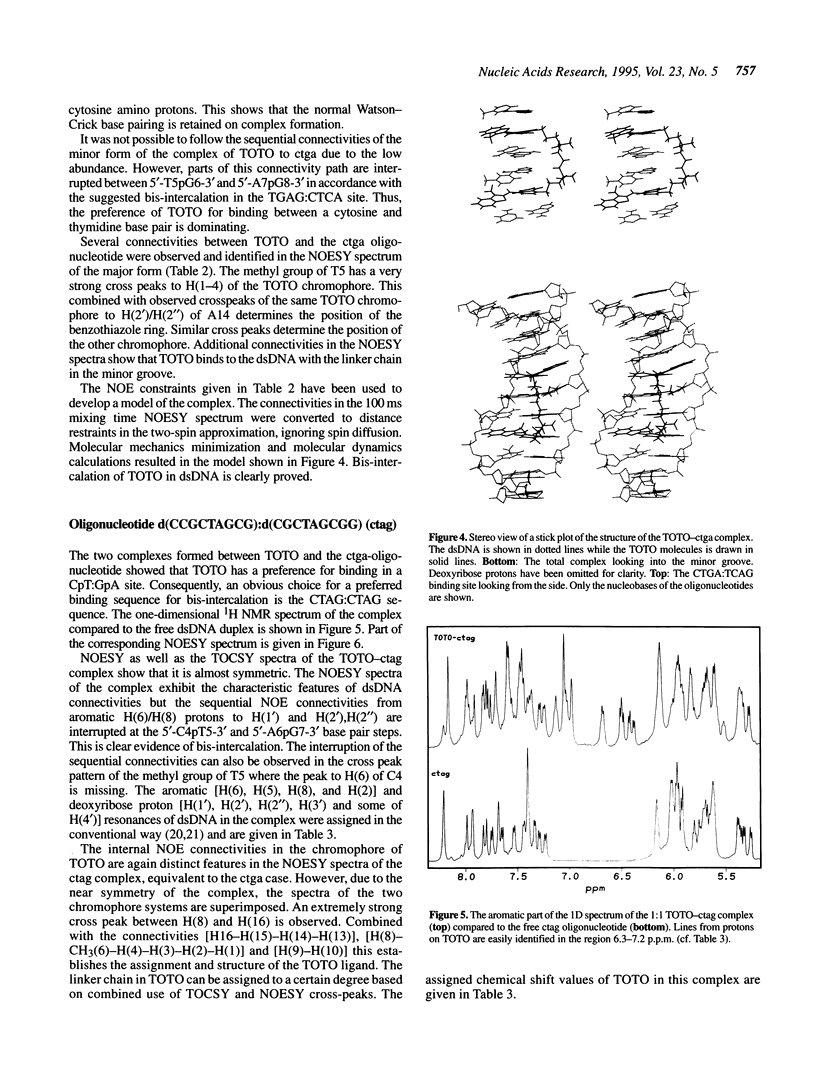
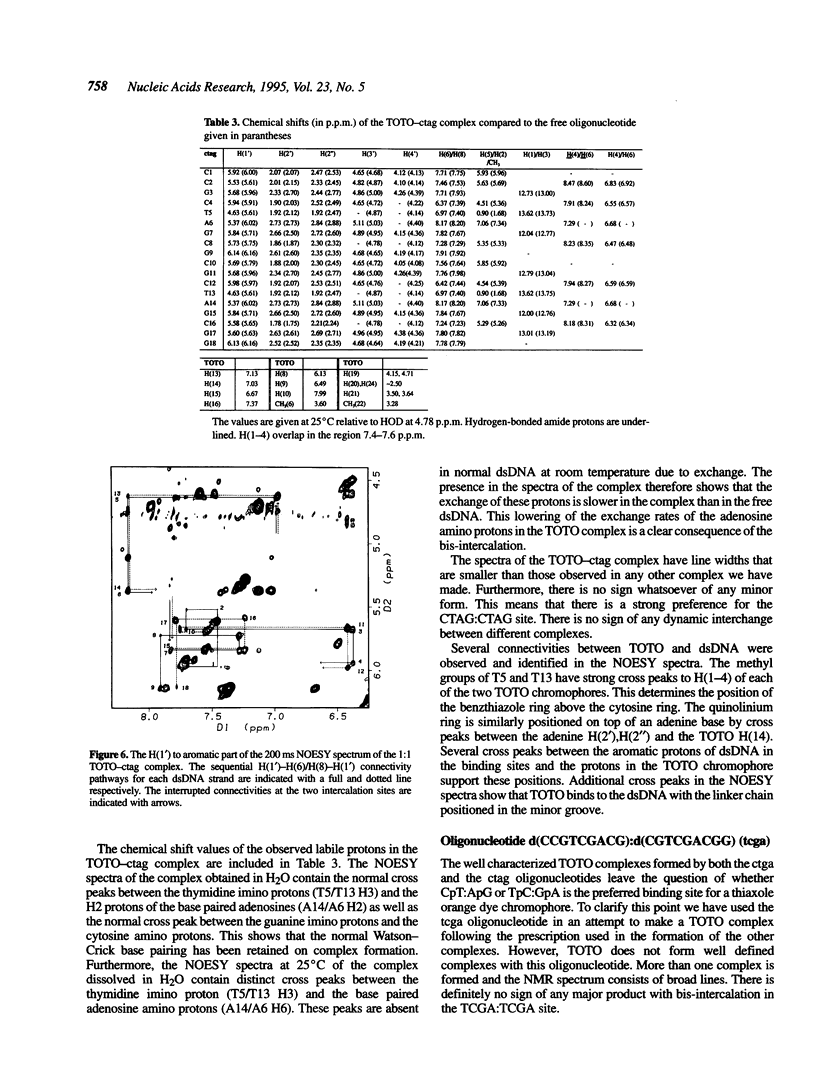
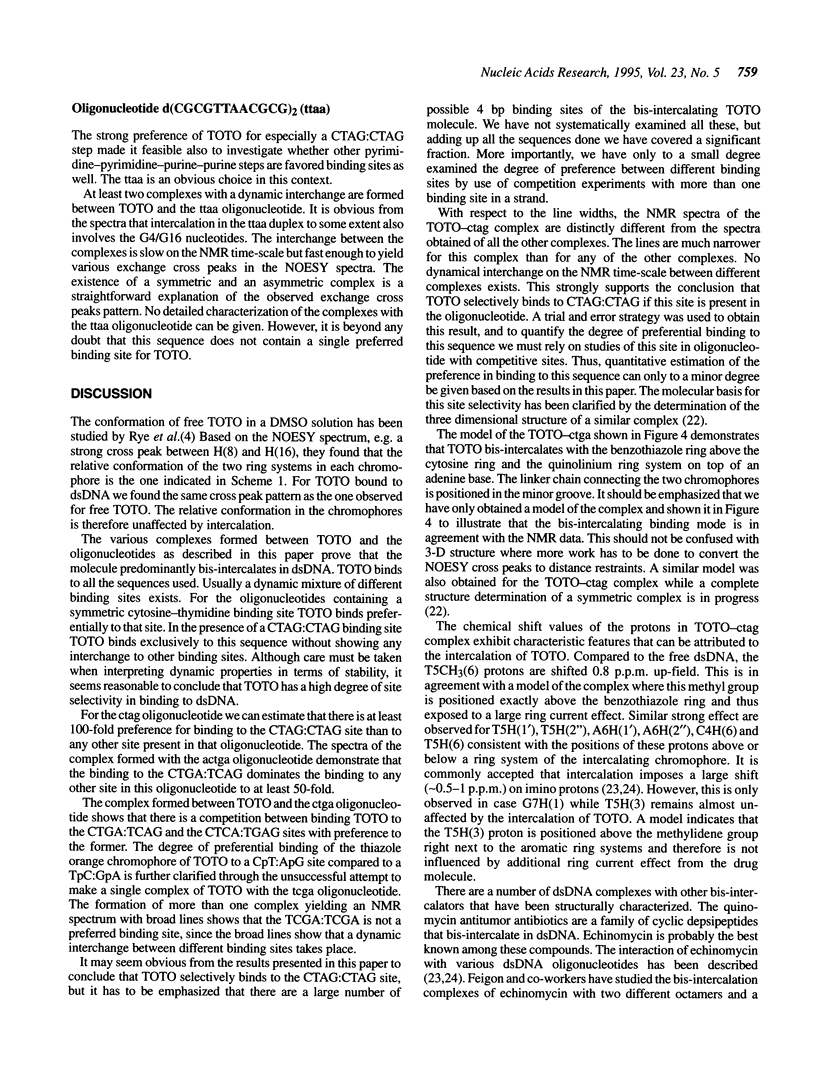
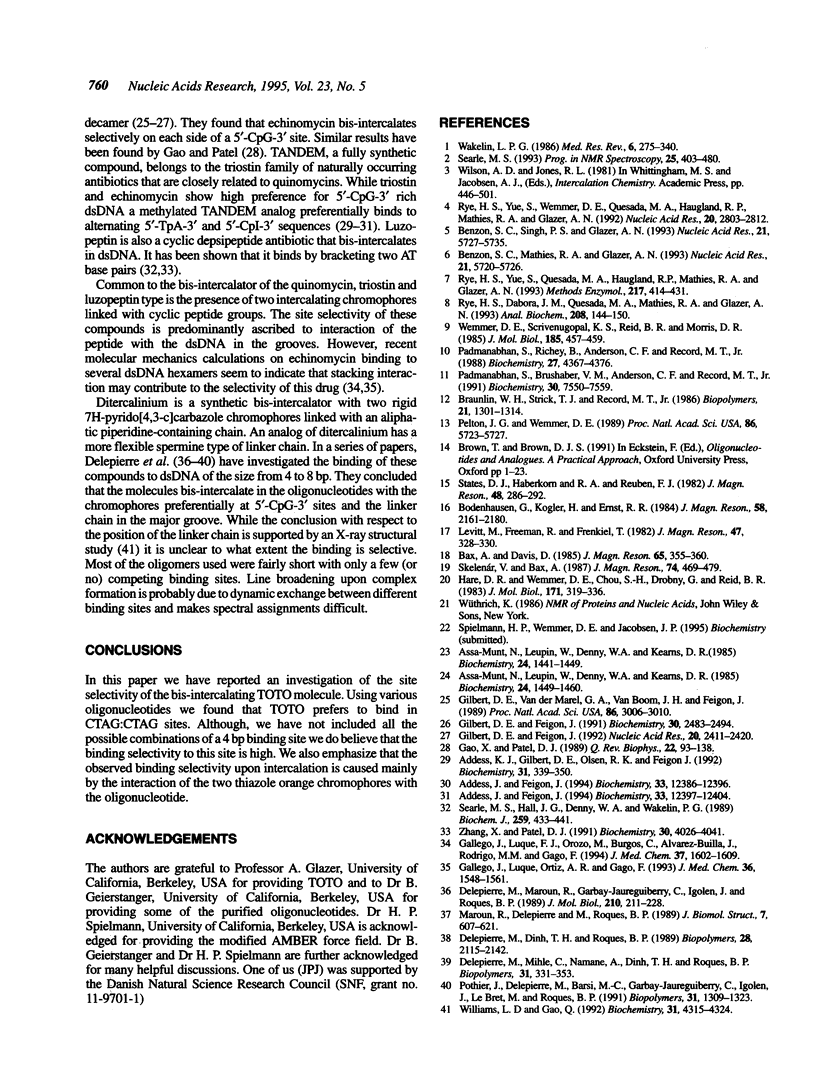
Selected References
These references are in PubMed. This may not be the complete list of references from this article.
- Addess K. J., Feigon J. Sequence specificity of quinoxaline antibiotics. 1. Solution structure of a 1:1 complex between triostin A and [d(GACGTC)]2 and comparison with the solution structure of the [N-MeCys3,N-MeCys7]TANDEM-[d(GATATC)]2 complex. Biochemistry. 1994 Oct 18;33(41):12386–12396. doi: 10.1021/bi00207a005. [DOI] [PubMed] [Google Scholar]
- Addess K. J., Feigon J. Sequence specificity of quinoxaline antibiotics. 2. NMR studies of the binding of [N-MeCys3,N-MeCys7]TANDEM and triostin A to DNA containing a CpI step. Biochemistry. 1994 Oct 18;33(41):12397–12404. doi: 10.1021/bi00207a006. [DOI] [PubMed] [Google Scholar]
- Addess K. J., Gilbert D. E., Olsen R. K., Feigon J. Proton NMR studies of [N-MeCys3,N-MeCys7]TANDEM binding to DNA oligonucleotides: sequence-specific binding at the TpA site. Biochemistry. 1992 Jan 21;31(2):339–350. doi: 10.1021/bi00117a005. [DOI] [PubMed] [Google Scholar]
- Assa-Munt N., Denny W. A., Leupin W., Kearns D. R. 1H NMR study of the binding of Bis(acridines) to d(AT)5.d(AT)5. 1. Mode of binding. Biochemistry. 1985 Mar 12;24(6):1441–1449. doi: 10.1021/bi00327a024. [DOI] [PubMed] [Google Scholar]
- Assa-Munt N., Leupin W., Denny W. A., Kearns D. R. 1H NMR study of the binding of bis(acridines) to d(AT)5.d(AT)5. 2. Dynamic aspects. Biochemistry. 1985 Mar 12;24(6):1449–1460. doi: 10.1021/bi00327a025. [DOI] [PubMed] [Google Scholar]
- Benson S. C., Mathies R. A., Glazer A. N. Heterodimeric DNA-binding dyes designed for energy transfer: stability and applications of the DNA complexes. Nucleic Acids Res. 1993 Dec 11;21(24):5720–5726. doi: 10.1093/nar/21.24.5720. [DOI] [PMC free article] [PubMed] [Google Scholar]
- Benson S. C., Singh P., Glazer A. N. Heterodimeric DNA-binding dyes designed for energy transfer: synthesis and spectroscopic properties. Nucleic Acids Res. 1993 Dec 11;21(24):5727–5735. doi: 10.1093/nar/21.24.5727. [DOI] [PMC free article] [PubMed] [Google Scholar]
- Braunlin W. H., Strick T. J., Record M. T., Jr Equilibrium dialysis studies of polyamine binding to DNA. Biopolymers. 1982 Jul;21(7):1301–1314. doi: 10.1002/bip.360210704. [DOI] [PubMed] [Google Scholar]
- Delepierre M., Dinh T. H., Roques B. P. Bisintercalation of ditercalinium into a d(CpGpApTpCpG)2 minihelix: a 1H- and 31P-NMR study. Biopolymers. 1989 Dec;28(12):2115–2142. doi: 10.1002/bip.360281207. [DOI] [PubMed] [Google Scholar]
- Delepierre M., Maroun R., Garbay-Jaureguiberry C., Igolen J., Roques B. P. 1H and 31P nuclear magnetic resonance studies of the differences in DNA deformation induced by anti-tumoral 7H-pyrido[4,3-c]carbazole dimers. J Mol Biol. 1989 Nov 5;210(1):211–228. doi: 10.1016/0022-2836(89)90301-x. [DOI] [PubMed] [Google Scholar]
- Gallego J., Luque F. J., Orozco M., Burgos C., Alvarez-Builla J., Rodrigo M. M., Gago F. DNA sequence-specific reading by echinomycin: role of hydrogen bonding and stacking interactions. J Med Chem. 1994 May 27;37(11):1602–1609. doi: 10.1021/jm00037a010. [DOI] [PubMed] [Google Scholar]
- Gallego J., Ortiz A. R., Gago F. A molecular dynamics study of the bis-intercalation complexes of echinomycin with d(ACGT)2 and d(TCGA)2: rationale for sequence-specific Hoogsteen base pairing. J Med Chem. 1993 May 28;36(11):1548–1561. doi: 10.1021/jm00063a005. [DOI] [PubMed] [Google Scholar]
- Gao X. L., Patel D. J. Antitumour drug-DNA interactions: NMR studies of echinomycin and chromomycin complexes. Q Rev Biophys. 1989 May;22(2):93–138. doi: 10.1017/s0033583500003814. [DOI] [PubMed] [Google Scholar]
- Gilbert D. E., Feigon J. Proton NMR study of the [d(ACGTATACGT)]2-2echinomycin complex: conformational changes between echinomycin binding sites. Nucleic Acids Res. 1992 May 25;20(10):2411–2420. doi: 10.1093/nar/20.10.2411. [DOI] [PMC free article] [PubMed] [Google Scholar]
- Gilbert D. E., Feigon J. The DNA sequence at echinomycin binding sites determines the structural changes induced by drug binding: NMR studies of echinomycin binding to [d(ACGTACGT)]2 and [d(TCGATCGA)]2. Biochemistry. 1991 Mar 5;30(9):2483–2494. doi: 10.1021/bi00223a027. [DOI] [PubMed] [Google Scholar]
- Gilbert D. E., van der Marel G. A., van Boom J. H., Feigon J. Unstable Hoogsteen base pairs adjacent to echinomycin binding sites within a DNA duplex. Proc Natl Acad Sci U S A. 1989 May;86(9):3006–3010. doi: 10.1073/pnas.86.9.3006. [DOI] [PMC free article] [PubMed] [Google Scholar]
- Hare D. R., Wemmer D. E., Chou S. H., Drobny G., Reid B. R. Assignment of the non-exchangeable proton resonances of d(C-G-C-G-A-A-T-T-C-G-C-G) using two-dimensional nuclear magnetic resonance methods. J Mol Biol. 1983 Dec 15;171(3):319–336. doi: 10.1016/0022-2836(83)90096-7. [DOI] [PubMed] [Google Scholar]
- Padmanabhan S., Brushaber V. M., Anderson C. F., Record M. T., Jr Relative affinities of divalent polyamines and of their N-methylated analogues for helical DNA determined by 23Na NMR. Biochemistry. 1991 Jul 30;30(30):7550–7559. doi: 10.1021/bi00244a026. [DOI] [PubMed] [Google Scholar]
- Padmanabhan S., Richey B., Anderson C. F., Record M. T., Jr Interaction of an N-methylated polyamine analogue, hexamethonium(2+), with NaDNA: quantitative 14N and 23Na NMR relaxation rate studies of the cation-exchange process. Biochemistry. 1988 Jun 14;27(12):4367–4376. doi: 10.1021/bi00412a025. [DOI] [PubMed] [Google Scholar]
- Pelton J. G., Wemmer D. E. Structural characterization of a 2:1 distamycin A.d(CGCAAATTGGC) complex by two-dimensional NMR. Proc Natl Acad Sci U S A. 1989 Aug;86(15):5723–5727. doi: 10.1073/pnas.86.15.5723. [DOI] [PMC free article] [PubMed] [Google Scholar]
- Pothier J., Delepierre M., Barsi M. C., Garbay-Jaureguiberry C., Igolen J., Le Bret M., Roques B. P. Comparison of the bis-intercalating complexes formed between either ditercalinium or a flexible analogue and d(CpGpCpG)2 or d(TpTpCpGpCpGpApA)2 minihelices: 1H- and 31P-NMR analyses. Biopolymers. 1991 Oct;31(11):1309–1323. doi: 10.1002/bip.360311109. [DOI] [PubMed] [Google Scholar]
- Rye H. S., Dabora J. M., Quesada M. A., Mathies R. A., Glazer A. N. Fluorometric assay using dimeric dyes for double- and single-stranded DNA and RNA with picogram sensitivity. Anal Biochem. 1993 Jan;208(1):144–150. doi: 10.1006/abio.1993.1020. [DOI] [PubMed] [Google Scholar]
- Rye H. S., Yue S., Quesada M. A., Haugland R. P., Mathies R. A., Glazer A. N. Picogram detection of stable dye-DNA intercalation complexes with two-color laser-excited confocal fluorescence gel scanner. Methods Enzymol. 1993;217:414–431. doi: 10.1016/0076-6879(93)17080-o. [DOI] [PubMed] [Google Scholar]
- Rye H. S., Yue S., Wemmer D. E., Quesada M. A., Haugland R. P., Mathies R. A., Glazer A. N. Stable fluorescent complexes of double-stranded DNA with bis-intercalating asymmetric cyanine dyes: properties and applications. Nucleic Acids Res. 1992 Jun 11;20(11):2803–2812. doi: 10.1093/nar/20.11.2803. [DOI] [PMC free article] [PubMed] [Google Scholar]
- Searle M. S., Hall J. G., Denny W. A., Wakelin L. P. Interaction of the antitumour antibiotic luzopeptin with the hexanucleotide duplex d(5'-GCATGC)2. One-dimensional and two-dimensional n.m.r. studies. Biochem J. 1989 Apr 15;259(2):433–441. doi: 10.1042/bj2590433. [DOI] [PMC free article] [PubMed] [Google Scholar]
- Wakelin L. P. Polyfunctional DNA intercalating agents. Med Res Rev. 1986 Jul-Sep;6(3):275–340. doi: 10.1002/med.2610060303. [DOI] [PubMed] [Google Scholar]
- Wemmer D. E., Srivenugopal K. S., Reid B. R., Morris D. R. Nuclear magnetic resonance studies of polyamine binding to a defined DNA sequence. J Mol Biol. 1985 Sep 20;185(2):457–459. doi: 10.1016/0022-2836(85)90418-8. [DOI] [PubMed] [Google Scholar]
- Williams L. D., Gao Q. DNA-ditercalinium interactions: implications for recognition of damaged DNA. Biochemistry. 1992 May 5;31(17):4315–4324. doi: 10.1021/bi00132a024. [DOI] [PubMed] [Google Scholar]
- Zhang X. L., Patel D. J. Solution structure of the luzopeptin-DNA complex. Biochemistry. 1991 Apr 23;30(16):4026–4041. doi: 10.1021/bi00230a030. [DOI] [PubMed] [Google Scholar]


